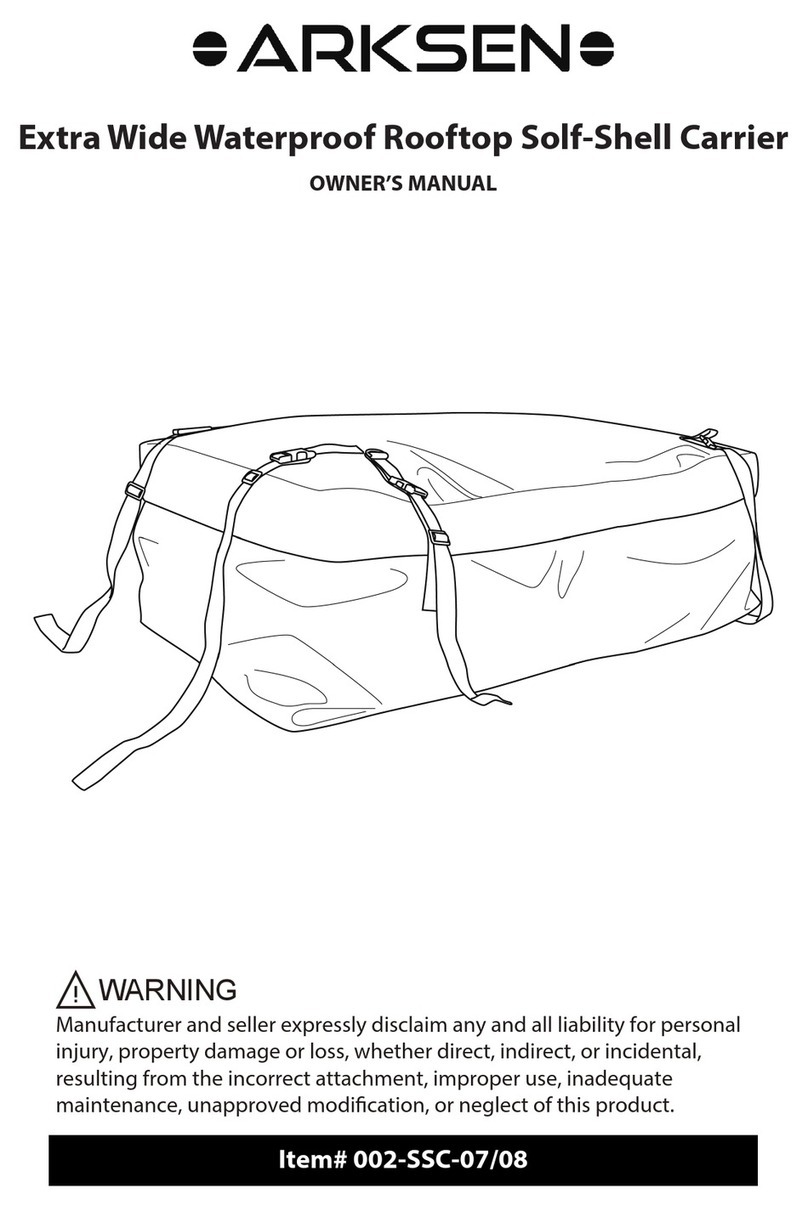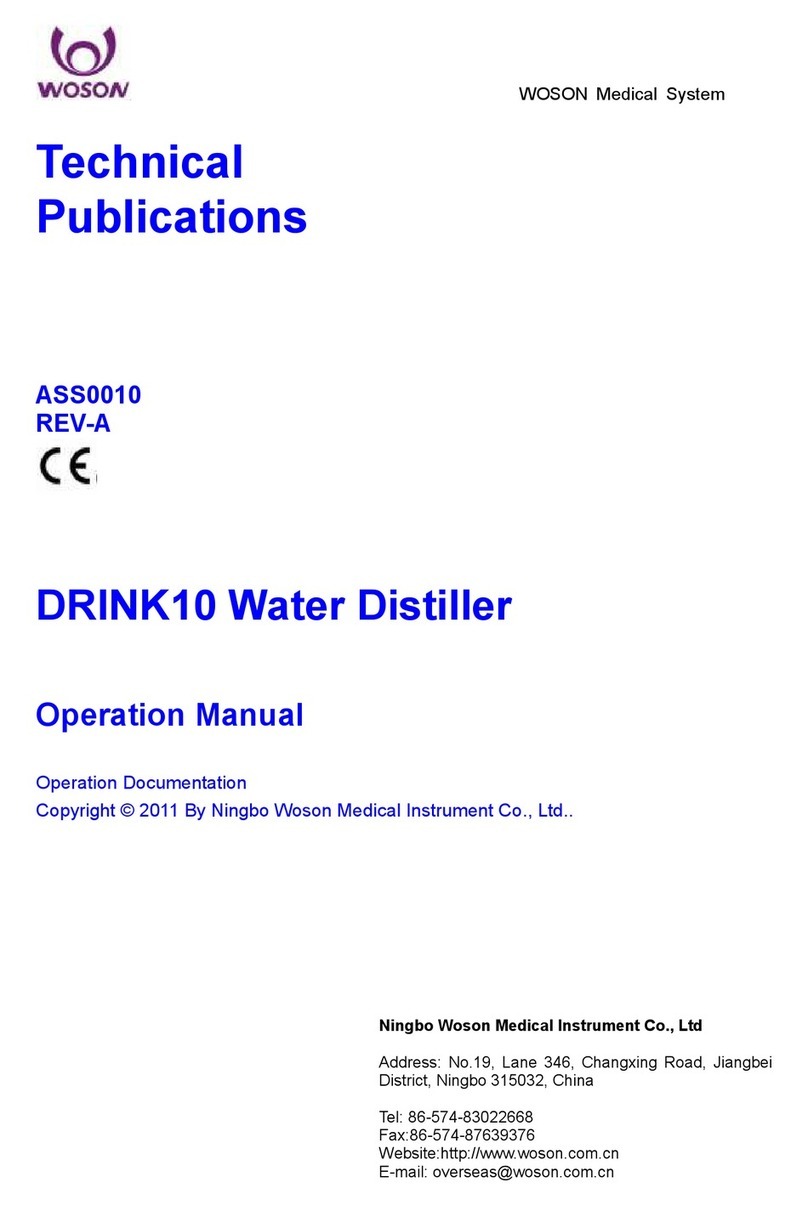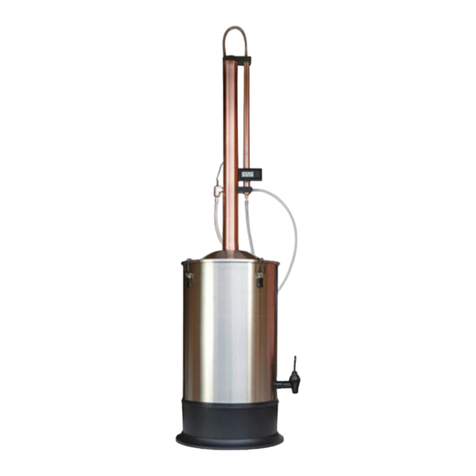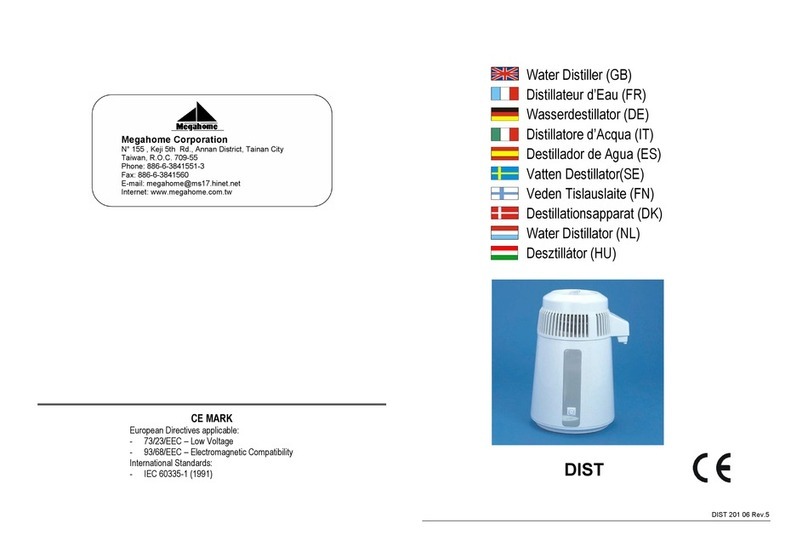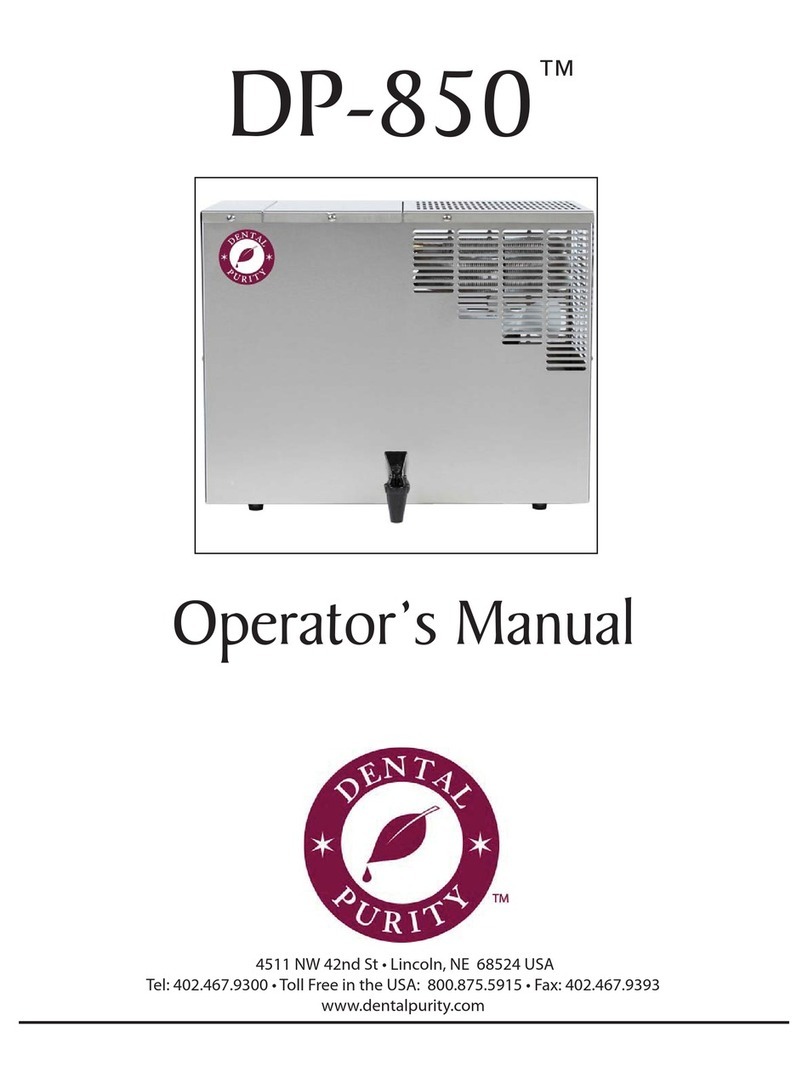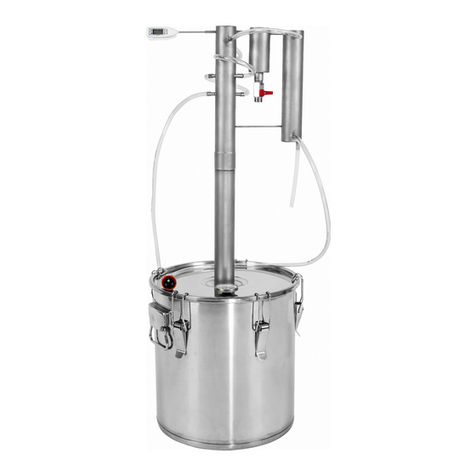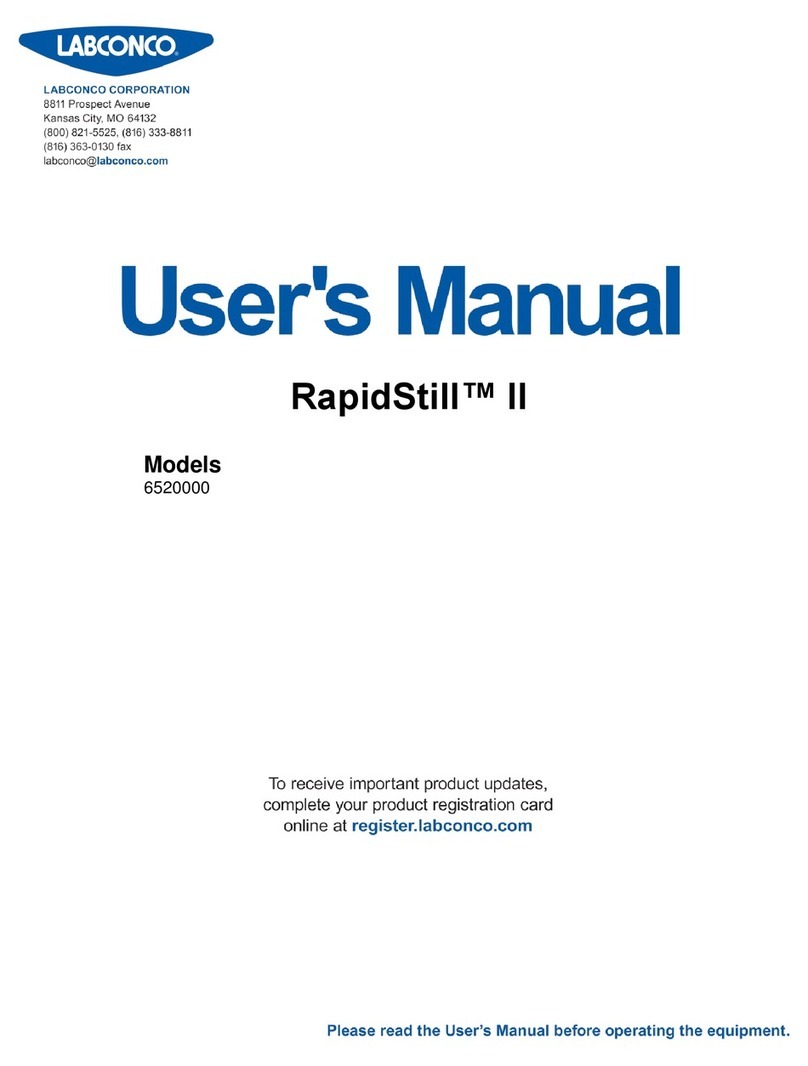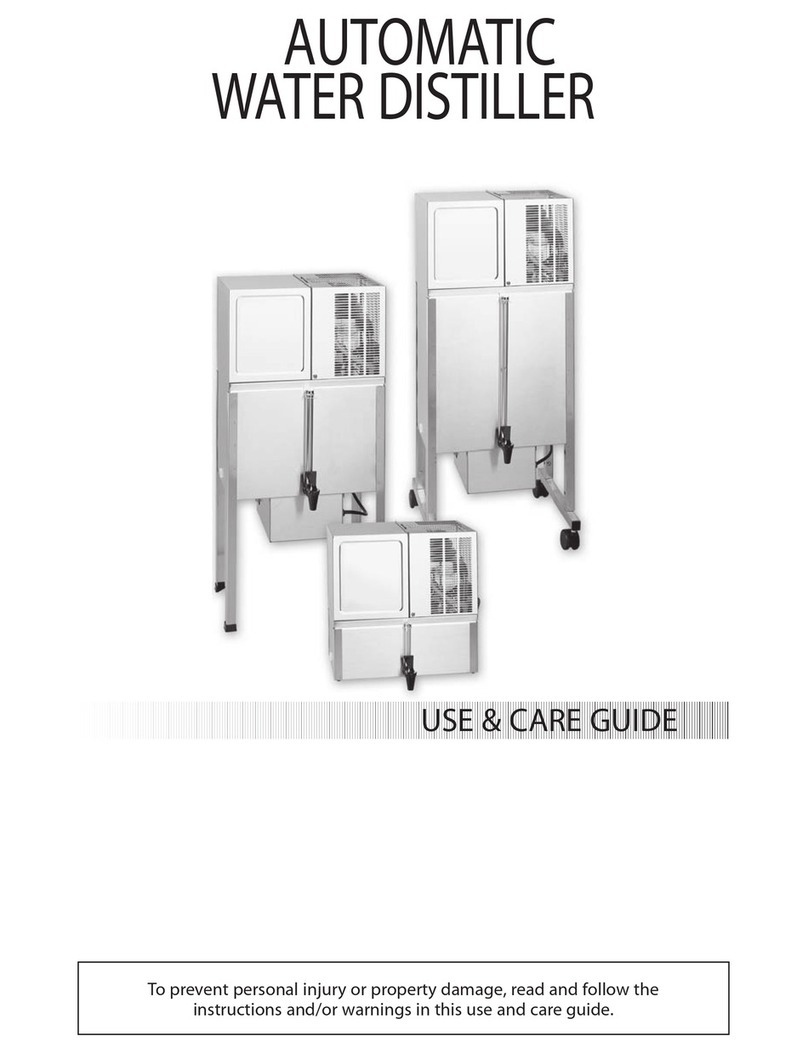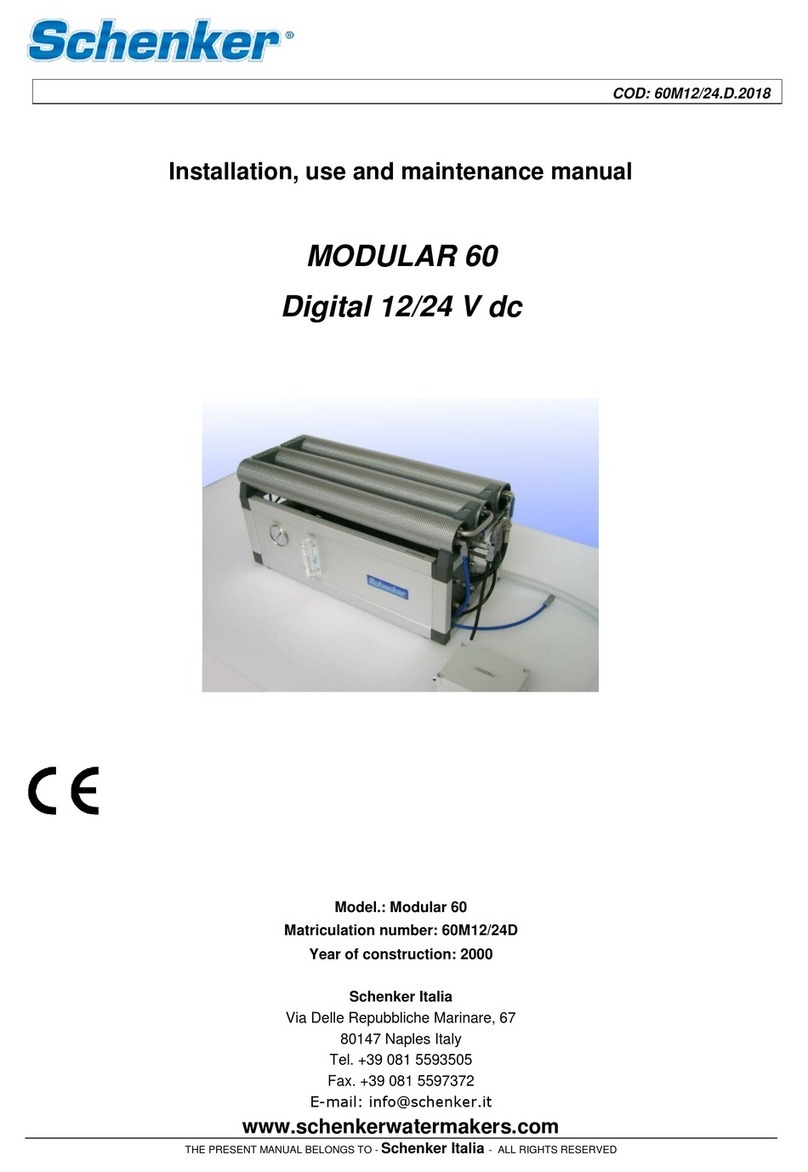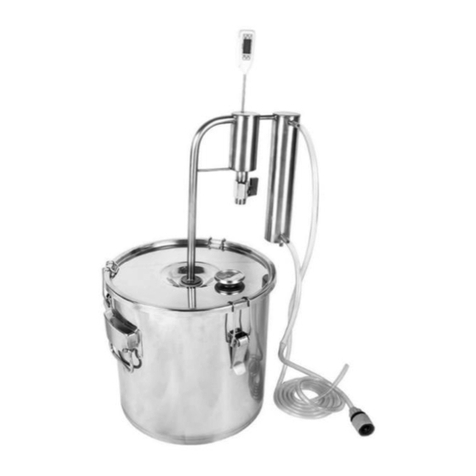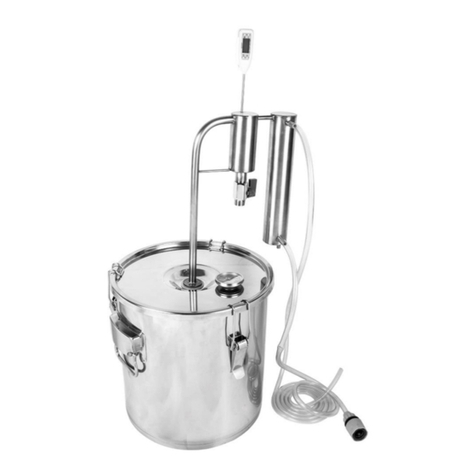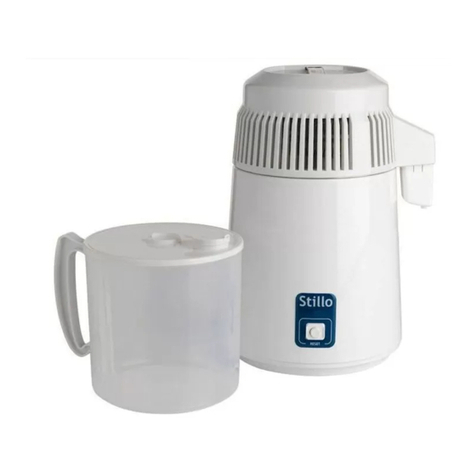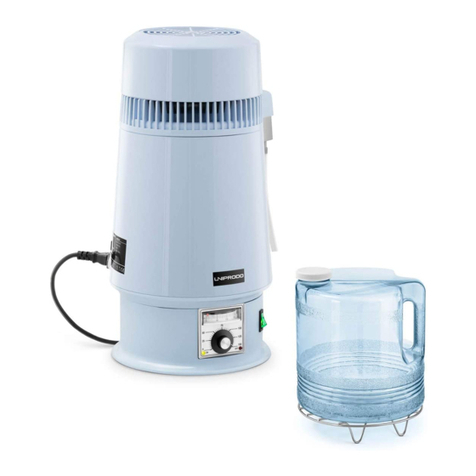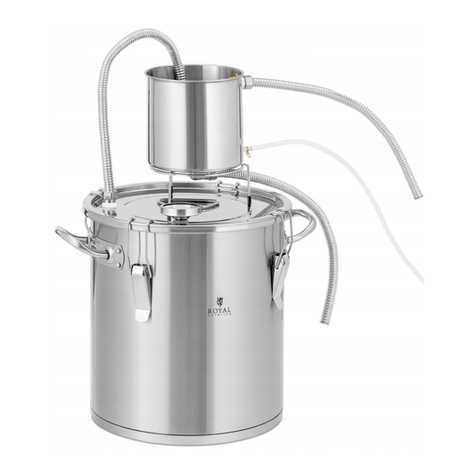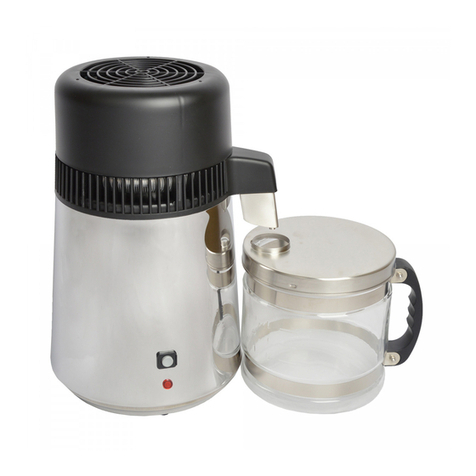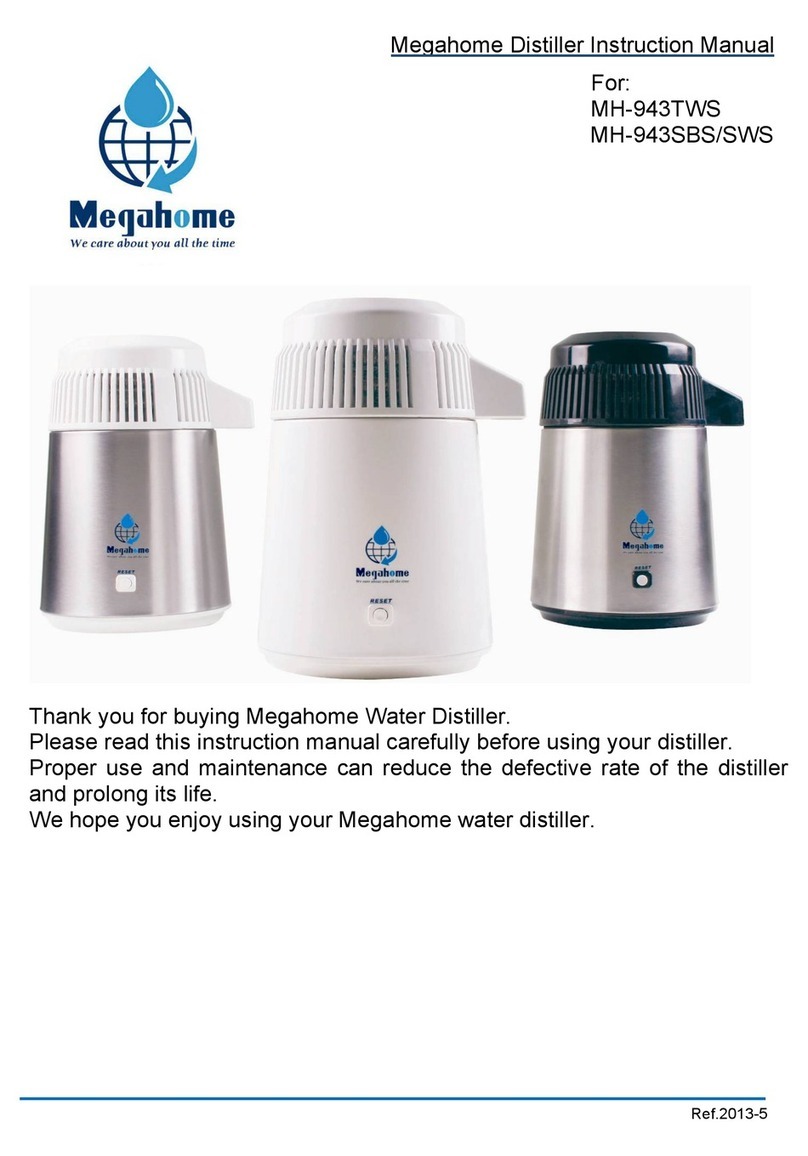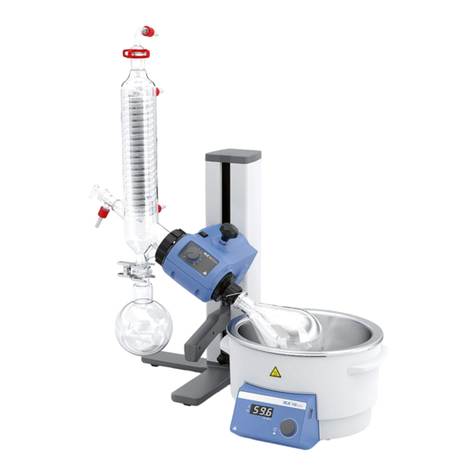Formeco Drester 120 User guide

INSTR: 11213-1 REV: 14-04-08/Bom GODK:
DRESTER 120
USE and MAINTENANCE
ENGLISH

Producer: FORMECO - Solvent Recovery Systems
Via Cellini, 33 – 35027 – NOVENTA PADOVANA (PD) – ITALY
Tel +39 049 8084 811 – Fax +39 049 8084 888
USE and MAINTENANCE
Solvent Distiller
R
RS
S1
12
20
0
Original instructions - Rev. 3.00
All rights reserved. Nothing from this publication is allowed to be copied in any way, whether electronically, mechanically or by photo-
copy or in any other way, without prior permission of the constructing company. Information in this manual can be changed without pri-
or notice.
The present manual contains instructions for optional devices that might not be installed on the machine.

- 2 -
INDEX
1. GENERAL INFORMATION 3
1. Distillation unit S for non flammable solvents 3
2. Distillation unit D for flammable solvents 3
3. Operating principle 3
4. Operation 3
5. Safety features 3
2. TECHNICAL INFORMATION 4
3. INSTALLATION PLACE 5
3.1. Installation place 5
4. ASSEMBLY AND INSTALLATION 7
4.1. Frame mounting 7
4.2. Floor fixing 7
4.3. Earth connection of the machine and the auxiliary vesselsFel! Bokmärket är inte definierat.
4.4. Bleeding valve 7
4.5. Verification of the cover gasket 8
4.6. Connecting the distillate tank 8
4.7. Electrical connection Fel! Bokmärket är inte definierat.
5. STARTING OPERATIONS 9
5.1. Positioning of the Rec- Bag 9
5.2. Solvent loading 9
5.3. Cover closing 10
5.4. Programming of the working cycle 10
5.5. Stop of the unit 12
5.6. Residue unloading 12
5.7. Important advices 13
6. SAFETY SYSTEMS AND ALARMS 14
6.1. Temperature safeties 14
6.2. Over pressure safety 14
7. DEFECTS AND SOLUTIONS 15
8. MAINTENANCE 17
8.1. Daily maintenance 17
8.2. Weekly maintenance 17
8.3. Maintenance every 2000 working hours 17
9. VACUUM GENERATOR (OPTIONAL) 20
9.1. General description 20
9.2. Technical details vacuum group 20
9.3. Connections 20
9.4. Testing 20
9.5. Vacuum switch 21
10. SPARE PARTS 22
10.1. Si7 / Si12 Fel! Bokmärket är inte definierat.
10.2. Di12 Fel! Bokmärket är inte definierat.
10.3. Si25 / Di25 Fel! Bokmärket är inte definierat.
11. DISASSEMBLY AND DEMOLITION 24
11.1. Disassembly 24
11.2. Demolition 24
12. WIRING DIAGRAMS 25
ANNEXES
CE (DECLARATION OF CONFORMITY)
WARRANTY CERTIFICATE

- 3 -
1. GENERAL INFORMATION
For the safe use of the FORMECO distillation units it is obligatory to read the general Distillation Guide as well as
this manual.
1.1. Distillation unit DT for non flammable solvents
The machines indicated with the first letters DT, are equipped with a splash-water proof electrical part (IP44) and can
be used only for the distillation of non-flammable solvents.
1.2. Distillation unit RS for flammable solvents
The machines indicated with the first letters RS, are equipped with an explosion proof electrical part (According to
ATEX ), and can be used in ZONE 1 and ZONE 2 and are suitable to distil both flammable and non-
flammable solvents.
1.3. Operating principle
Exploiting the principle of simple distillation, the unit separates the contaminations (such as resins, paints, pigments,
ink, oil, grease, etc.) from the original solvent, which, once recycled directly into a tank, can then immediately be used
again. The contamination remains on the bottom of the boiler and can easily be unloaded at the end of the cycle.
The boiling of the polluted solvent takes place in a boiler surrounded by a cavity space containing diathermic oil heated
by an electric element. The vapour is conveyed to an air cooled condenser and transformed back into a liquid state; the
condensed solvent is collected in a tank. The characteristics of the solvents will in no way be altered by the process if the
instructions are followed carefully. The number of distillations can hence be repeated indefinitely.
The unit allows the recovery and re-use of solvents with a boiling point between 50 and 180 °C. Using a vacuum unit
(optional) solvents with a boiling point up to 220 °C can be recycled.
1.4. Operation
The operation cycle is fully automatic, the intervention of the operator is only necessary for loading the solvent to be
distilled (1), setting temperature and distillation time (2) and unloading of the residues (3-4).
1.5. Safety features
The distillation unit operates at atmospheric pressure.
Cases of abnormal high temperature increase or faulty operation of the condenser are signalled and the machine stops
automatically.
1
4
3
2

- 4 -
2. TECHNICAL INFORMATION
Description U.M. RS 120
Installed power kW 1.06
Heating power
kW 1.0
kcal/h 868
Voltage V 230
Frequency Hz 50
Section mains cable mm21.5
Fuses or magnet switches A 4.5
Ground connection mm26
Maximum surface temperature °C 195 (for T3 machines) or 225 (for T2 machines)
Sound level dB (A) 64
Geometric boiler volume litres 19
Loading volume liters 12 - 15
Compressed air connection (for vacuum) BSP13/8 '' F
Pressure min / max bar 6/8
Diameter of piping mm 6 x 8
Compressed air consumption l / 1' 30 – 35
Width mm 590
Depth mm 600
Height mm 1400
Weight kg 80
Containment bund mm 2500x2500
Collection drain mm 500x500x600
1BSP = British Standard Pipe (cylindrical Gas thread)

- 5 -
3. INSTALLATION LOCATION
3.1. Installation location
For the correct installation of the distillation unit it is necessary to classify the risk area, and as-
sure a proper ventilation and the use of certified electrical and non-electrical equipment ac-
cording to ATEX 95 (directive 94/9/EC)
LEGEND
1 Feed box 7 Lighting
2 Fuses or magnet switch 8 Distillate outlet
3 Feeding cable 9 Earth connection
4 Compressed air connection (for optionals) 10 Containment basement
5 Collection reservoir 11 Roof
6 Distillation unit 12 Fire extinguisher
It is necessary to install fire extinguishers (12), in correct places and in adequate number. The extinguishers must be for
fires of class B (fires of inflammable liquids) and class C (inflammable gas fires). Warning signs have to be installed
bringing attention to the possible dangers.
If the machine is installed outside, it has to be protected by a roof (13).
When treating flammable solvents, all electrical equipment present (lighting, sockets, etc.) have to be installed according
to the existing norms regarding the areas of explosion risk.
a. Containment bund
The containment bund (10) for machines up to 120 litres can be formed by a metallic bund. For bigger ma-
chines the floor can be in cement with a small wall, to contain accidental spillage. The volume of the bund
should be at least 1.5 times the amount of solvent in the machine.
The basement should have a slight slope (1%) towards the collection reservoir (5).
b. Collection reservoir
To collect accidental spills.
The collection reservoir should have a size to be able to install a pump to remove the accidentally spilled sol-
vent (e.g..: 500 x 500 x depth 600 mm).

- 6 -
3.2. Electrical connection
Verify that the electrical circuits of the distillation unit have not been damaged during transport. Check that
the screws on the cable connector and of the earth connections are well tightened. Verify that the voltage
and the frequency of the power supply coincide with the data on the identification tag of the machine.
Install a power supply (2) together with :
main switch for the machine
n° 3 fuses or magnet switches set at 50% over the absorbed current of the machine
Connect a plug to the feeding cable of the machine.
a. Earth connection of the machine and the auxiliary vessels
Connect the unit support, the containment basin and connected drums with an isolated earth cable to an effi-
cient earth connection.

- 7 -
4. ASSEMBLY AND INSTALLATION
4.1. Frame mounting
Remove the machine from its packing and place it in the required location according to the following instruc-
tions.
Allow a free space around the machine of al least 1000 mm, to be able to for the operator and to the mainte-
nance staff to access the machine without any problems. This area should remain free to be able to access all
parts of machine if necessary.
a. Packing
Remove the machine from the transport hole Aand slide it into hole B, install the washer provided. Lock the
rotation of the machine with the spring loaded pin. Finally, install the reinforcement cross member with the
screws.
b. Floor fixing
Fix the machine to the floor with screws through the prearranged holes.
c. Bleeding valve
Remove the plastic cap from the oil expansion vessel and screw on the oil bleeding valve provided in place of
the cap.

- 8 -
d. Verification of the cover gasket
According to the type of solvent to be distilled, the proper cover gasket must be utilized.
See the table for the used codes.
RS 120 Type Colour Description
359001 STANDARD Black For general use and for solvent mixtures. Un-
less specified, it is mounted standard on the
unit.
359002 ACETONE Grey For pure acetone or for diluents with a high
percentage of acetone.
359003 VITON Green For chlorinated solvents (methylene chloride,
Freon, chlorothene, trichloroethylene, perchlo-
roethylene, etc.)
239004 UNIVERSAL White Suitable for all solvents.
4.2. Connecting the distillate tank
Put a container of proper size in line with the distillate discharge nozzle. To connect the nozzle with the con-
tainer, it is advisable to use a solvent-resistant rubber pipe in order to avoid evaporation and possible odours.
The tube must enter the container only for a few centimetres in order that it is never submerged in the distil-
late. Furthermore the connecting tube should not have bends and curves to avoid over-pressure formation in
the boiler and possible vapour escape.
The container should be made of metal and it is necessary to earth it.
The container must not be sealed in order to allow a free air circulation. Provide a flame block on the air out-
let when distilling flammable solvents.

- 9 -
5. STARTING OPERATIONS
5.1. Solvent loading
The solvent loading has to be done manually with the help of a container, or with through a loading
pump. Make sure not to pour solvent into the vapour manifold: the first distillate would come out dirty
a. WITH LIQUID CONTAMINANTS (oil, ink, etc.)
Pour the solvent to be distilled into the boiler up to the reference sign which indicate the maximum
level.
b. WITH SOLID CONTAMINANTS (paints, polyester resins, etc.)
Always use the non re-usable 'RecBag'. In this way the unit will always work with the maximum efficiency,
the cleaning will be facilitated and the operator will not have to breathe in noxious vapours.
5.2. Rec-Bags
The Formeco Rec-Bags are tested according:
EC Type Examination Certificate TÜV-SUD – TPS 05 ATEX 2 163 X
EPH Test Certificate
The formulation of the material of the Rec-Bag has been studied and approved for the use in potential-
ly explosive atmospheres of Zone 0, 1 and 2 and Gas Group IIA. They cannot be used for group IIB
and IIC.
The use of non-original bags can provoke fire or explosion risks due to the accumulation of electrostat-
ic charge on the bags during distillation.
It is therefore prohibited to use non-original bags. The use of non-original bags voids the warranty on
the machine as well as the ATEX certification. Formeco declines any responsibility for possible damag-
es that, directly or indirectly, may be caused to persons or property as a consequence of the use of
non-original bags.
The Rec-Bags are made to work with neutral solvents up to a temperature of 160 °C and can
be used for only one distillation/drying cycle. For working temperatures up to 180-200 °C, ask
for the 'RecBag T'. In cases where it is not possible to use the RecBag, we advise to use some
Formeco detaching product to enable the easy removal of the residue.
5.3. Positioning of the Rec-Bag
Pull the bottom corners inward and place the Rec-Bag in the boiler, making sure that the bag adheres
perfectly to the boiler wall. Air bubbles between the bag and the boiler surface have to be avoided.
Insert the Ring-Bag in the boiler
Block the Rec-Bag using the stop ring 'Ring Bag'.

- 10 -
5.4. Solvent loading
Pour the solvent to be distilled into the boiler up to the reference sign which indicate the maximum
level. Make sure not to pour solvent into the vapour manifold: the first distillate would come out dirty.
The machine is equipped with a lateral loading pipe for easy connection to the washing booth.
5.5. Cover closing
1. Hook the cover closing handle over the cover bar. When closing the cover, pay attention not to damage
the cover seal.
2. Rotate the cover closing handle to complete the cover closure.
1 2
5.6. Programming of the working cycle
a. Command panel RS 120
1 Red light: Alarm
2 Working thermostat
3 Green light: Power ON
4 Cycle timer
5 Green light: Heating ON

- 11 -
b. Control board RS 120 LCD
1 ON-OFF + Setting of process time
2 Liquid Crystal Display
3 Setting of process temperature
LCD managing
<h>
11200
Machine stopped
In the display is indicated the total
process time of the plant.
*02 : 15
Time setting
On the left bottom side the symbol *
flashes for 8 seconds till the required
process time will be settled.
For setting a new process time, place the
knob in the position “OFF” and repeat the
setting operation above.
02 : 15
Machine working
In the display is indicated the active
heating by the symbol and the
countdown of the settled time.
ALARM
02 : 10
Alarm
In the display is indicated the alarm state
by the flashing words “ALARM”.
During this event the machine passes,
automatically, to the cooling phase for 20
minutes. Ventilation fan activated and
heaters deactivated.
At the end of the cooling time, reset the
plant (see specific chapter in the
instruction manual).

- 12 -
02 : 10 SERVI CE
Service
In the display is indicated also the word
“SERVICE” which flashes when 2000
working hours have been reached; it is
time to replace the thermal oil.
After having replaced the oil, re-set the
plant switching 8 times the knob
“ON/OFF” (see specific chapter in the
instruction manual).
c. Temperature setting
Set the working thermostat to a temperature of 20-30 °C higher than the boiling temperature of the
solvent to be distilled. In the case of Nitro based products or Synthetics set the working temperature at
160 °C.
If the residue has to be dried, the working thermostat has to be set to 170-180 °C.
For more information on distillation temperatures, see the specific tables in the General Handbook.
Some solvents (e.g. halogenated solvents) are thermally unstable. Pay attention to the working
temperature, otherwise the product will acidify. Set the thermostat on the working temperature
as reported in Table of Non-flammable Solvents.
d. Timer setting
The first time, set the distillation timer at the maximum setting; the time between the beginning of the
cycle and the moment in which no more distillate comes out of the unit will be considered the optimal
time. This time is to be set for successive distillation cycles.
Normally a cycle lasts for 3-4 hours. For drying the residue this time can be prolonged with 15-30
minutes.
Distillation time depends on the type of solvent distilled as well as the degree of contamination. The
indicated distillation times are therefore to be regarded as purely indicative and they refer to a distilla-
tion cycle with cold machine start up. In case of more consecutive distillation cycles, the time of the cy-
cles after the first can be reduced with about 30 minutes.
e. Start of the unit
Switch on the power to the machine with the main switch. The Mains green indicator light and operation
green indicator light will switch on: thus the cycle begins.
The distillate will start to flow out after about 40-50 minutes.
At the beginning of the distillation, check the correct out flow of solvent from the distillation
unit to the collection tank.
The correct functioning of the distillation unit has to be checked at least every 90 minutes.
5.7. Stop of the unit
At the end of the preset time the heating will stop automatically. The condenser air-fan will operate for an-
other 20 minutes.
To stop the unit manually, rotate the timer knob to 0 (zero).
5.8. Residue unloading
Before proceeding with the removal of the distillation residue, wait until the diathermic oil temperature is be-
low 50 °C. Turn of the power by turning the main switch.
Provide a container for the collection of the residue and open the cover by:
1. Rotating the locking lever to unlock the cover

- 13 -
2. Unhook the eccentric lever from its position
In the presence of liquid residues, rotate the machine using the handle. For the model RS120 it is necessary
to unlock the machine with the knob on the side of the machine. The machine can be locked with the same
knob in the unloading position.
In the presence of solid residue, remove the retaining ring and remove the Rec-Bag inside the boiler paying
attention not to break it. The small amount of solvent that might have formed on the bottom of the boiler
can be removed like described above.
5.9. Important advice
Do not rotate or shake the unit once loaded or when operating.
Clean the oil expansion vessel only with a 'wet' rag to avoid generating sparks.
Opening the cover sooner than one hour after the distillation cycle has finished will cause the cover gasket to
swell.
Some solvents during the distillation phase create such a quantity of foam that a correct separation of the sol-
vent from the polluting product is not possible. In these cases the distillate will be dirty. This inconvenience
can be overcome by using the optional antifoam kit.
Model RS 120
ANTIFOAM KIT 301900

- 14 -
6. SAFETY SYSTEMS AND ALARMS
6.1. Temperature safeties
The distillation unit is equipped with safety features to control the proper working temperature.
A safety thermostat is also installed on the distillate outlet, to assure the proper working conditions.
a. Working temperature
Distillation unit in Temperature Class T2
ST1 Working thermostat 50 - 210 °C
Distillation unit in Temperature Class T3
ST1 Working thermostat 50 - 185 °C
b. Maximum temperature diathermic oil
Distillation unit in Temperature Class T2
ST4 Maximum thermostat (fixed setting) 225 °C
Distillation unit in Temperature Class T3
ST4 Maximum thermostat (fixed setting) 190 °C
The maximum safety thermostat has a manual reset. To reset the thermostat it is necessary to:
1. isolate the power from the machine using the main switch;
2. open the control box of the machine;
3. verify the reason for the thermostat intervention, if necessary replace the defective thermostat;
4. push the reset button on the thermostat to reset it
c. Distillate temperature
ST3 Maximum thermostat on condensate (fixed setting) 40 °C
When the distillate temperature rises above 40°C, this thermostat momentarily blocks the heating of the ma-
chine.
Verify the reason for the alarm, replacing the thermostat if necessary.
d. Temperature alarm
In case the maximum thermostat ST4 or the condenser thermostat ST3 go in alarm, the red alarm light
comes on.
6.2. Over pressure safety
The working cycle of the machine is performed at atmospheric pressure or under vacuum (for the models
equipped with optional vacuum group).
The cover of the boiler acts as over-pressure valve. The safety valve intervenes at 0,1 bar above atmospheric
pressure.
In case of overpressure formation in the boiler, the machine has to be stopped and the cause for the over-
pressure has to be removed.
Do not interfere with the spring of the cover to prevent the outflow of vapour.

- 15 -
7. DEFECTS AND SOLUTIONS
DEFECTS CAUSES REMEDIES
During automatic loading the machine
does reach the level controller (optional)
The set loading time is too short Augment loading time
Low compressed air pressure Higher the air pressure to increase the
loading speed of the pump
The unit is ‘ON’ but does not heat Working thermostat at zero Set working temperature
Electrical resistance burned out Change the electrical resistance
One of the thermostats is faulty Change the faulty thermostat
The distiller heats but does not distil
Boiler is dirty Clean the boiler
Solvent boiling temperature is higher
than the one set on working thermo-
stat
Set a higher temperature on the work-
ing thermostat
Solvent boiling point is higher than
distiller maximum working tempera-
ture
Change the solvent with one that has
a lower boiling point or distil under
vacuum with suitable kit (optional)
Diathermic oil is worn out Change the diathermic oil
Lack of diathermic oil Top up the diathermic oil till the mini-
mum level when the machine is cooled
down
The unit distils only part of the dirty sol-
vent
Insufficient operating time Increase the operating time
The undistilled fraction has a boiling
temperature higher than the set tem-
perature on the working thermostat Set a higher temperature on the work-
ing thermostat
Solvent boiling point is higher than dis-
tiller maximum working temperature Change the solvent with one that has
a lower boiling point or distil under
vacuum with suitable kit (optional)
The working thermostat is defect Change the working thermostat
Distillation time is much longer than the
maximum setting time
There is a considerable percentage of
water in the dirty solvent Replace the solvent
Lack of diathermic oil Top up the diathermic oil till the mini-
mum level when the machine is cooled
down
Diathermic oil is worn out Change the diathermic oil
The electrical resistance is scaled Take out the diathermic oil and clean
the electrical resistance
The cycle does not stop at the time set
on the working timer Cycle timer is defect Replace cycle timer
The distillate comes out dirty
Unit has been loaded with a quantity
higher than the maximum Load the exact quantity
Solvent foams
Load with a lower quantity
Use the anti-foam kit
Reduce working temperature
Temperature set on working thermo-
stat too high Reduce working temperature
Vapour manifold or vapour condenser
dirty Wash manifold and condenser by pour-
ing in clean solvent with a funnel or by
blowing in compressed air
Distillate takes on a greenish colour Condenser is corroding
The solvent is acid, replace the copper
condenser with a stainless steel one
The temperature setting is too high and
the solvent acidifies: set a lower working
temperature
If the temperature set on the working
thermostat is correct, acidification has
occurred before the distillation. Replace
the solvent immediately.

- 16 -
DEFECTS CAUSES REMEDIES
The solvent bleeds out of the cover
Worn out gasket Replace the gasket
Vapour manifold is clogged Wash manifold and condenser by
pouring in clean solvent with a funnel
or by blowing in compressed air
Vapour condenser is clogged Replace the condenser
The distillate outflow is blocked
Wash the discharge line by pouring clean
solvent in the vapour manifold with a
funnel and blow with compressed air
Check that the discharge line is not un-
der the distillate level in the collection
vessel
The 'RecBag' is damaged Working temperature too high Reduce the working temperature
Use 'RecBag T'
The solvent is acid Distil only neutral solvents
Cover gasket swells The boiler cover is opened when the
machine is still hot
Wait until the oil temperature has
sunk under 50 °C, before opening the
cover
The cover gasket is not suitable for
the type of solvent treated Mount the suitable gasket
Smoke comes out from under the cover Overheating of the polluting products or
presence of nitrocellulose
Reduce the working time and/or temper-
ature. Possibly distil under vacuum with
the suitable kit (optional)
Worn out gasket Replace the gasket
The red indicator light switches on
“ALARM”
Diathermic oil temperature is higher
than the maximum allowed one: ther-
mostat of maximum temperature inter-
venes
Replace the working thermostat and re-
set the maximum thermostat by pushing
the reset button of the thermostat
Distillate temperature is over 60 °C Verify the correct functioning of the con-
denser and its fan
Ambient temperature is too high Ventilate the room or do not work at
very warm days
Ventilator motor burnt out Replace ventilator motor
Vapour condenser dirty on the outside Clean with a compressed air jet
The security thermostat of the con-
denser is defected Call the producer for the setting or re-
placement of the thermostat
The red indicator light flashes
“ALARM” The machine has reached 2000 working
hours Replace the oil and clean the heating el-
ement

- 17 -
8. MAINTENANCE
The maintenance has to be performed by specialised personnel that are adequately trained.
For the annual maintenance and for the changing of the diathermic oil it is advised to request assistance from
an authorised service centre or to the manufacturer.
8.1. Periodic ATEX verification
The electrical installations in areas with explosion risks have specific characteristics that make them apt to op-
erate in such areas. It is essential, for safety reasons, during the lifecycle of the apparatus, to maintain these
characteristics; therefore a periodic control is necessary that is at least once every three years (EN 60079-).
This control has to be performed by qualified personnel.
In the occasion of maintenance or repair on the machine, the qualified personnel can perform the necessary
checks.
8.2. Daily maintenance
a. Cleaning of the boiler
Clean daily the inside of the boiler, removing crusts and deposits that might have been formed. In that way
the heat exchange between diathermic oil and solvent remains at its optimum.
b. Check diathermic oil
Check the diathermic oil level in the oil expansion vessel when the unit is cold. If necessary top up the level.
8.3. Weekly maintenance
a. Cleaning of the condensation circuit
Blow with compressed air into the vapour manifold to remove deposits that might have been formed by en-
trainment or boiling over.
Clean the outside of the condensation section with compressed air.
8.4. Maintenance every 2000 working hours
After 2000 working hours the red alarm light will start to blink. Replace the diathermic heating oil and clean
the electrical heating element. This maintenance should be done with a cold machine.
After this maintenance the hour counter will have to be reset.
The machine has to be disconnected from the main power when performing the following maintenance.
a. Diathermic oil change
Set up a collecting container under the machine to collect the used diathermic oil.
Oil type: FORMECO LT200, MOBILTHERM 605, ESSOTHERM 500, SHELL ThermiaB,
TOTAL Seriola 1510. For different brands, use diathermic oil with a cracking temperature
higher than 320 ° C and a viscosity of about 31 cSt at 40 °C and 5,3 cSt at 100 °C.
b. Diathermic oil change RS 120 machines
Model RS120
Oil quantity (litres) 6,5

- 18 -
1. Remove, by unscrewing, the oil bleeding valve (1);
2. Place the collecting container (2) and rotate the machine; remove the cover and unscrew the loading plug
of the oil (3) to let the oil flow out.
3. Blow dry compressed air (4 ÷ 6 bar) in the plug to remove any formed debris.
4. Put the machine in a horizontal position and fill up the machine with new oil through the loading plug,
using a funnel. Leave about 0,5 litres of oil behind for the final top-up of the machine.
5. Insert the plug and the cover again (8), and place the machine upright again
6. Without installing the bleeding valve (9) and without loading the machine, turn the unit on at maximum
temperature. Having reached the maximum temperature, add slowly (in two or three times) the remain-
ing oil in the expansion vessel until the expansion vessel (10) is at the right level.
7. Turn off the machine, and when is has cooled down, reinsert the bleeding valve (9).
At every oil change, the oil breather valve on the expansion vessel must be changed.
c. Cleaning the electrical heater element
1. Rotate the unit 90°. Remove the lid of the heater unscrewing the security dowel using a hexagonal key of
2 mm (1A);
2. Disconnect the electrical wires using a box spanner (2A);
3. Unscrew the element using a spanner of 90 mm. (3A);
4. Remove and clean the electrical heater element (4A);
5. Reinstall the electrical element using a Teflon ribbon for the sealing (5A).

- 19 -
Normally when cleaning the element it is convenient to also change the diathermic oil and in
this case it can be poured directly into the hole of the element.
d. Reset the hour counter
1. Open the control box
2. Push the button Afor resetting the hour counter.
Table of contents
